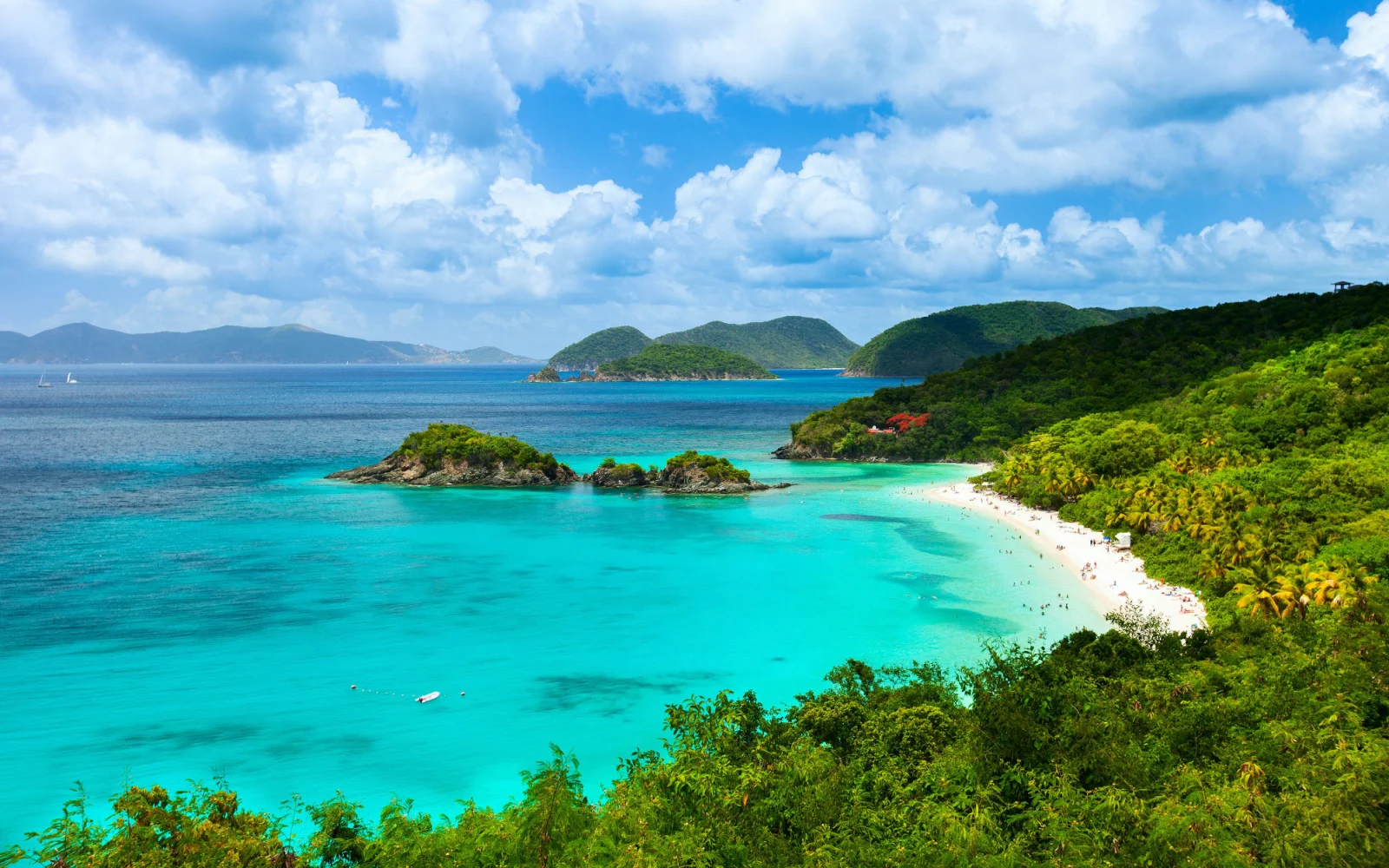What's the average trip to the U.S. Virgin Islands cost?
A one-week trip to the U.S. Virgin Islands for two typically costs around $5,200. This includes accommodation at $250 per night, flights at $500 per person, and food, activities, and transportation. The British Virgin Islands tend to be more expensive, but costs can be reduced by planning and exploring local options.
The Virgin Islands are the Caribbean’s premier vacation spot. In fact, the U.S. Virgin Islands have been called “America’s Paradise” and the British Virgin Islands are a less commercialized option replete with uncrowded parks and local culture.
With beaches, mountains, dazzling scenery and comfortable temperatures year-round, the V.I. are an idyllic destination for hiking, snorkeling, water sports or just relaxing on the beach, perhaps with the rum concoction known as a painkiller.
Unfortunately, the Virgin Islands are not an ideal spot for a budget vacation. These islands host many wealthy travelers, and much of the commercial activity is focused on servicing rich people.
This is even more true in the British V.I. Still, with planning and forethought, you can enjoy a trip to this tropical wonderland without making your bank account scream.
Read on for some guidelines about what a typical trip to the Virgin Islands costs, and some tips on how to minimize those expenses.
Average Trip to Virgin Islands Cost in 2025
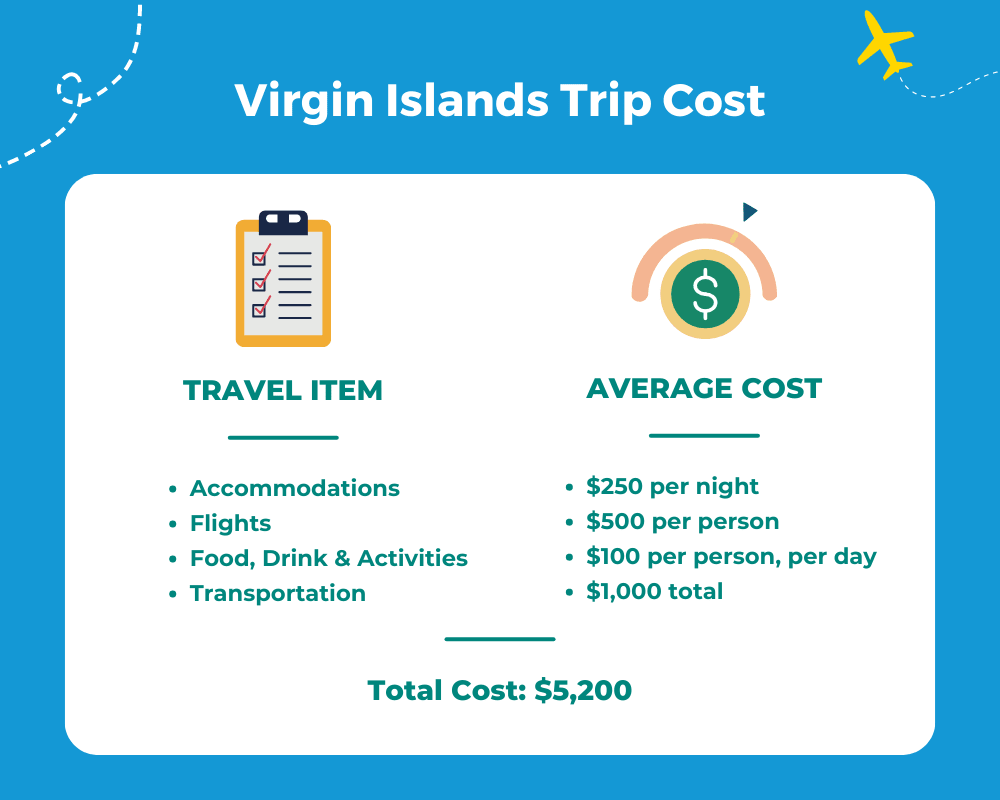
A one-week trip to the U.S. Virgin Islands for two will cost around $5,200:
- Average Accommodation Cost: $250 per night
- Average Flight Cost: $500 per person
- Food, Drink & Activities: $100 per person per day
- Transportation: $1,000 total
- Total Cost: $5,200
For this price, you can rent a car, visit more than one island, sample tourist and recreational activities and eat some but not all of your meals in restaurants. With planning you can spend less, and, if luxury is your watchword, you can spend much more.
Prices drop a bit during the low season, from May to November. However, that’s also the rainy season and the hurricane season. The threat of severe storms is highest in late summer and lower on the spring and fall ends of the rainy season.
Because of trade winds, the temperatures are moderate, in the 70s and 80s, all year round. April through June may be the “sweet spot” with less than the highest prices and not too much risk of bad weather.
The islands feature festivals throughout the year. If you time your visit to overlap with one, you’ll enjoy street parades and live music at no cost.
Virgin Islands Trip Cost: Average by Item
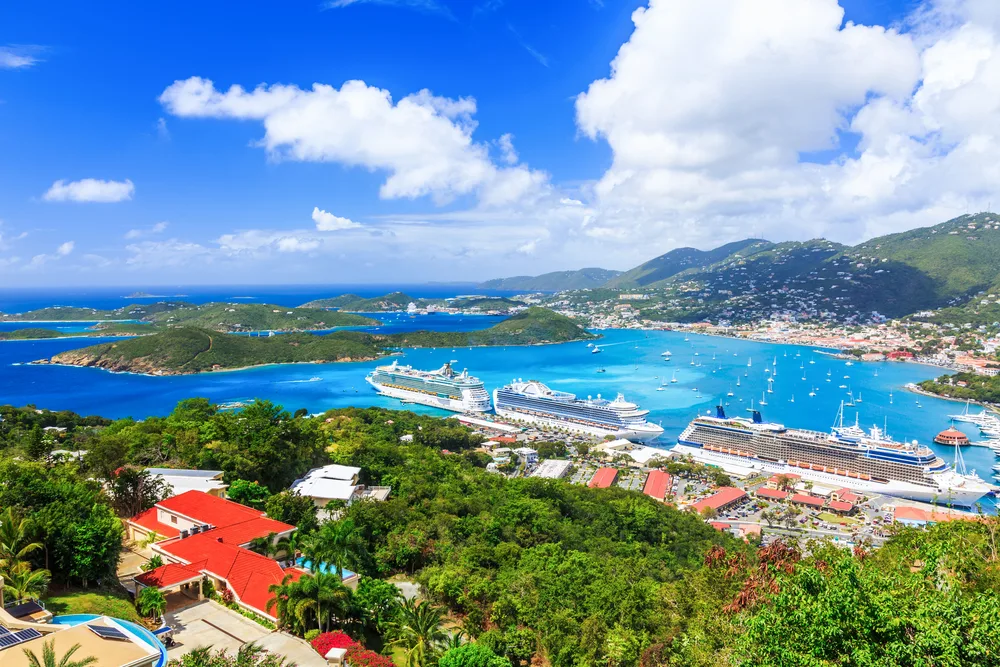
SCStock/Shutterstock
The British Virgin Islands are costlier than the USVI and one of the most expensive locales in the Caribbean. They have a reputation as a “billionaires’ playground,” and they tend to be quieter with lots of exclusive resorts and secluded beaches.
Four main islands – Tortola, Virgin Gorda, Anegada and Jost Van Dyke – make up the BVI, while most visitors to the USVI center their trips around one of the three larger islands, St. Thomas, St. John and St. Croix.
The USVI have all-inclusive resorts, where accommodations and meals, and often even flights, are included in the deal.
These are generally three or four night vacations. Prices might be as reasonable as around $1,000 per person in the low season and up to $5,000 and even more for the best resorts during prime time.
Accommodation Costs
There’s no getting around it: hotels in the Virgin Islands are expensive. The average room in the USVI runs around $250 a night. The BVI can be even higher. Furthermore, there aren’t many competing alternatives that offer budget-minded tourists some relief.
There are no hostels. Airbnbs and similar opportunities are limited, although more are popping up. You’ll have to book early to nab one. Such accommodations can be as low as $100 or less.
The lowest prices are in less convenient locations with limited views. USVI does has a few campgrounds. Cabins might run $75 a night, and tent campers can pitch for $30-$40.
The all-inclusive resort is another option, but remember that their listed prices are usually per person, not per room. Even the most affordable will be close to $1,000 ($2,000 a couple) for a three-day experience, and the best are multiple times that.
Still, many tourists choose this 3-4 day trip. If you find a good deal, the price might be in the same ballpark as seven “regular” days.
Flight Costs
The Virgin Islands are close enough to mainland U.S. that bargain flights can be found, especially from the Southeast. You might locate a round-trip ticket from Florida for not much over $100.
As you get farther away from the V.I., ticket costs go up. If you fly on the weekend from the middle of the country, a ticket could be over $1,000. Flying during the week and searching in advance will save you money.
$500 is roughly an average cost looking at airports all over the U.S. and booking judiciously. In the USVI, there are airports on St. Croix and St. Thomas.
Many travelers will choose to center their vacation around one of the islands and visit the others by ferry. Ferries also connect with the BVI and with Puerto Rico during the busy season.
St. Croix is the largest island, while St. Thomas, with the capital city of Charlotte Amalie, is the busiest. The third island, St. John, is more relaxed with fewer resorts and over half the island occupied by Virgin Islands National Park.
Food, Drink & Activity Costs
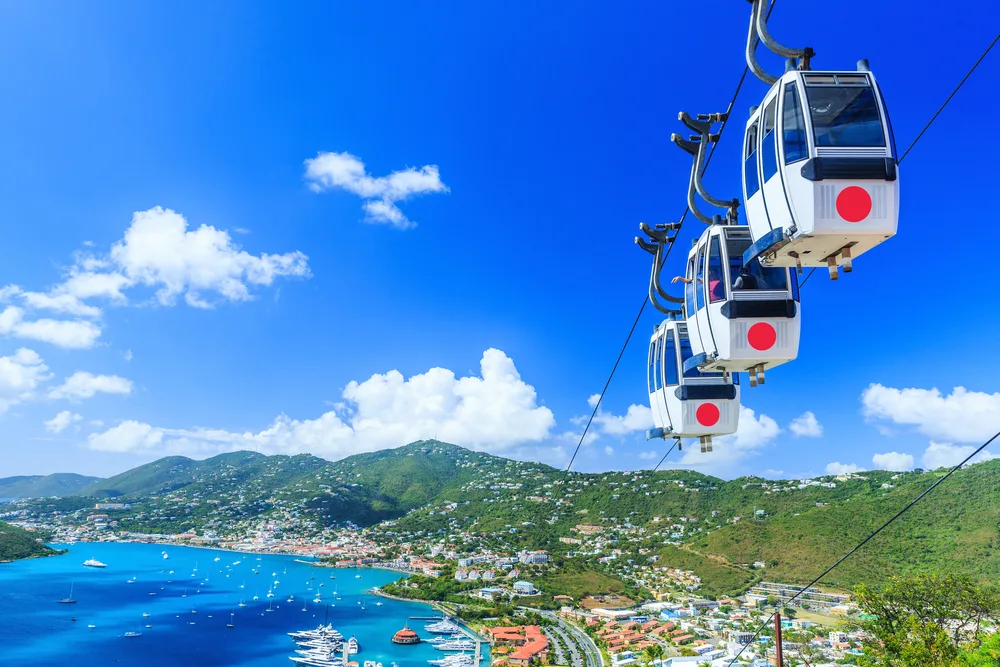
SCStock/Shutterstock
In the Virgin Islands, most food is imported. You can save money by shopping grocery stores, even though prices are higher than mainland U.S. If you eat in a restaurant, you might spend $20 or more for a meal, less for breakfast.
There are roadside restaurants and food trucks where you can sometimes find a filling meal for as little as $10. The V.I. diet is seafood-centric, but the locals also eat and serve plenty of goat and pork.
Fresh fruit is available in season at roadside stands. A lot of the local dishes are stews and soups with plenty of herbs and vegetables. Give gumbo-like callaloo and the cornmeal dumplings called fungi a try.
Beans and rice is a staple, seasoned with plenty of herbs and spices. There are high-end restaurants, usually affiliated with hotels, for those who want to splurge.
St. Croix in particular is gaining a reputation as a foodie destination. Happy hours are not uncommon in the USVI. You might find dollar drinks and reduced prices on bar snacks.
You can spend a lot or a little, but many tourists find themselves laying out around $50 per person per day. If you drink beer, wine or Caribbean rum refreshments such as the painkiller, you may spend another $20 or more.
Many tourists spend little on activities, instead passing their days by enjoying the beach. If you do want to get out and about, there’s plenty to do and see. It doesn’t cost anything to hike in the hills or wander around historic Charlotte Amalie.
However, there are also museums, guided tours and charters. Some travelers will choose a charter or two and book before they arrive in the V.I. to save money and guarantee a spot. An evening cocktail cruise is a must for many.
For water sports lovers, there are paddleboards, surfboards and kayaks available for rent in the $65-$100 range. Many tourists spend about $50 a day for various activities, but you can choose to spend next to nothing.
Transportation Costs
Unless you plan to stay close to your hotel, you’ll want a car. Public transportation is limited, and if you’re inclined to explore, buses don’t go everywhere you want.
Auto rental is expensive and may run around $700 for the week for a jeep or similar vehicle suitable for the rough, hilly roads. An alternative is to spend a few days carless in your local area and a few days exploring more widely.
The more adventurous can rent a motorcycle or even a scooter. One oddity: although both the USVI and the BVI drive on the left, many USVI autos have the steering wheel on the right-driving side, i.e., the left.
To visit more than one island, use the car ferries. Plan on spending around $50 for a one-way trip. For local transportation, bus service is reasonable during the day but unreliable after dark.
Taxis are readily available, but there aren’t ride shares. There are also trucks that call themselves “safaris.” They loop around towns, not on a set schedule, during the day. Stick your thumb out and hop on. Most rides are just a dollar or two.
Things to Consider
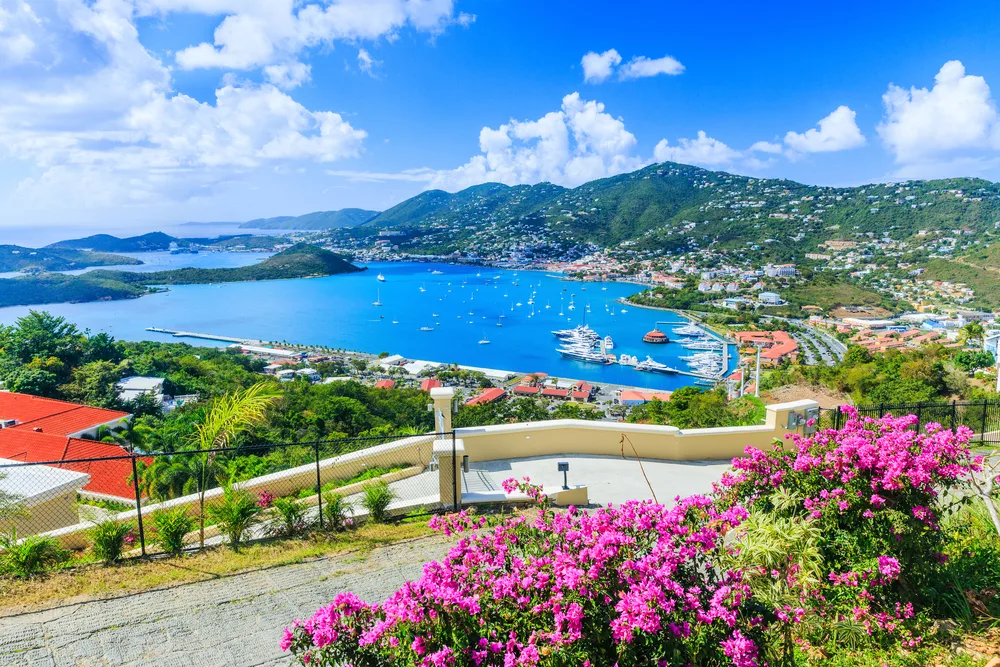
SCStock/Shutterstock
Here are few islands facts to be aware of:
- The USVI looks and feels a lot like mainland U.S., but there are differences. Perhaps the greatest is that things are slower. In some cases, a lot slower. Set reasonable expectations around speed and efficiency when dealing with local businesses.
- When speaking with a Virgin Islander, avoid the temptation to jump right in and get to the point. Always begin with a greeting – “Good morning,” “Good afternoon” or “Good night.” Manners are valued in these islands. An exception: don’t expect subtlety from cab drivers or store barkers. They’ll aggressively solicit you, and it’s fine to ignore them.
- While it’s not part of baseline vacation costs, you might want to bring some money for shopping. St. Thomas is the tax-free, duty-free shopping mecca of the Caribbean. Americans can bring home up to $1,600 in duty-free purchases.
Frequently Asked Questions

Denis Moskvinov/Shutterstock
How many days are enough for Virgin Islands?
You could fly in for a long weekend and enjoy it. 3-4 day all-inclusive trips at a resort also work. However, to do some traveling and get a feel for several islands, five days is a minimum and a full week is better.
Is the BVI or USVI better?
It depends on what you’re looking for. The USVI has more going on, including shopping, restaurants and activities for children. However, if you’re looking to get away to a deserted beach, the BVI is more exclusive and more natural. It’s also more expensive.
What is the best island to stay on in the US Virgin Islands?
Each of the three main islands is different. For nightlife and a lot of activities, choose St. Thomas. For a quieter experience and more time with nature, St. John is your best bet. St. Croix doesn’t have the activity level of St. Thomas, but the culinary scene is as good as any in the Caribbean.
Is it safe to travel to the Virgin Islands right now?
The V.I. are a fun and safe experience and highly recommended. There are no travel advisories from the U.S. State Department. There is crime in the USVI among islanders involved in illicit activities, but tourists are seldom affected even by petty crime.
What ethnicity lives in Virgin Islands?
Most people are Blacks descended from slaves, although the number of Puerto Ricans and continental Americans in the USVI has increased in recent years.
What languages do they speak in Virgin Islands?
English is the USVI official language and the most widely spoken one. Occasionally you’ll hear Spanish or French Creole.
Do you need cash for Virgin Islands?
Most hotels and large businesses take cards, but you’ll need cash for boutiques, curio shops and roadside food vendors. As an American territory, the USVI uses U.S. dollars.
Do you need a passport to go to the Virgin Island?
U.S. citizens do not need a passport to travel to the USVI, since it’s an American territory. They will, however, need one for the BVI.
So, What Is the Average Cost for a Virgin Islands Trip?
| 🛎️ Average Accommodation Cost | $250 per night |
| ✈️ Average Flight Cost | $500 per person |
| 🍽️ Food, Drink & Activities | $100 per person, per day |
| 🚕 Transportation | $1,000 total |
| 💲 Total Cost | $5,200 |
A one-week trip to the U.S. Virgin Islands for two will cost about $5,200. There are ways to lower this cost. You can sometimes buy plane tickets at bargains prices. You might hold down food costs by buying groceries or eating at roadside venues.
However, inexpensive accommodations are hard to find, and car rental – a necessity if you want to explore – is not cheap. A week in the British Virgin Islands will generally be more expensive.
Regardless, we’ve shown you a few ways to save on your trip, so what are you waiting for — book your vacation today and experience for yourself all that the Virgin Islands have to offer. Happy travels!



